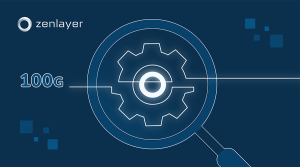The World Cup was undoubtedly the dazzling finale of the sports scene in 2022 – a year filled with memorable moments. With a final penalty shootout, Messi and Argentina took home the gold. As the CDN technology providers for live broadcasting in Vietnam, Zenlayer and Alibaba Cloud supported a total of 64 games broadcasted in real time by TV360, a subsidiary of Viettel – the largest mobile network operator in the country. Their joint efforts gave millions of fans in Vietnam smooth and enjoyable livestreaming experiences.
Before we dive into the details, let’s first go over the basics of the content delivery network (CDN), how it ensures the best viewing experience, and why it’s critical for live broadcasting and streaming services.
What is CDN and how does it work?
A CDN is a globally distributed network of servers that store web content close to users for accelerated delivery. The primary purpose of a CDN is to reduce latency – or delay in the arrival of data – for users as they access online content. For media companies in today’s world where video and audio quality are growing increasingly higher in resolution, CDN has grown to become an essential part of the distribution infrastructure.
A CDN functions by replicating content and caching it within servers in various locations. As a user accesses the content, the CDN will reroute their requests to be fulfilled by whichever server is geographically closest to that user, significantly cutting down distance-induced latency.
What benefits does a CDN bring to broadcasting and streaming companies?
A CDN employs various technologies to speed up and stabilize content distribution to ensure timely delivery and a smooth viewing experience for the user. Of course, timely delivery is never more important and unforgiving than when the content is being streamed live and in real-time. As touched on above, caching with a CDN reduces the physical distance between the user and the content being requested. This not only helps the user access content faster but also helps reduce the stress on the origin server.
CDNs are designed to handle massive amounts of traffic that ordinary servers aren’t built to process efficiently. This is particularly critical whenever the content happens to be coverage of breaking news, a worldwide event like the World Cup, or when a video “goes viral” – ascending in popularity extremely quickly and unexpectedly. Without a CDN, large spikes of traffic that follow as a large number of viewers across the world all try to access the same content simultaneously will easily blow past the origin server’s bandwidth cap and congest its internal network. This increases latency for all viewers across the board and can incur monumental costs to the company serving up said content – both in dollars and in viewer satisfaction.
Even if one CDN server does bend under the weight of all that traffic, load balancing can help spread its traffic load across other nearby servers. This ensures that viewers experience minimal disruptions to their video and audio, eliminating jitter, stutter, and repeated buffering that frustrate viewers and cause abandonment.
And, of course, a CDN can help save money because rather than spending immense amounts of capital to build and maintain the massive and complex infrastructures needed for content delivery, the broadcasting or streaming company can pay a manageable, predictable subscription fee to its CDN provider. This opens up resources that can be invested into exciting new content that would otherwise go into IT and dedicated personnel needed to continually monitor, maintain, and update servers.
Zenlayer and Alibaba Cloud’s joint solution reduced World Cup 2022 livestreaming latency to <20 milliseconds
Each World Cup is not only a festival for the fans, but also a critical test for network performance and stability — especially for CDN technology and service providers.
As the event was hosted in Asia, Vietnamese fans were exceptionally excited for this World Cup. This comes as no surprise given the recent explosion in popularity of video streaming in the country. In fact, within a five-year span from 2018 to 2022, revenue for video streaming in Vietnam has grown by 187% to $187.6 million and is projected to reach $330.8 million by 2027.
Live broadcast service providers were expected to carry billions of concurrent connections, and the large number of playoffs required bandwidths several times higher than that of regular games. Further, Vietnam falls within the larger emerging market in Southeast Asia, where few providers have the local expertise backed by a history of high performance offered by Zenlayer or Alibaba Cloud. In response to this astronomical demand, the two partnered to improve transmission speeds by reducing latency for live broadcasts of the sporting event to <20 ms while improving download speed by 2+ Mbps.
From the resource needs for each game and the number of available providers, Zenlayer calculated the bandwidth distribution for fans around the world. Domain names and core indicators such as node traffic levels, round-trip time (RTT), packet loss, download speed, and back-to-source traffic were monitored in real time with alerts to ensure resource availability.
Looking ahead, Zenlayer will continue to collaborate with Alibaba Cloud to improve streaming experiences for the ASEAN Cup and other future events. We look forward to creating more value with cloud innovations and content delivery for our customers and the world.
Improve your viewer’s streaming experience with Zenlayer
Zenlayer’s CDN technology and services helped ensure smooth and engaging livestreaming experiences of the most recent World Cup for millions of fans in Vietnam. Our global network of 290+ edge nodes and 5,400+ global peers brought every thrilling, action-packed moment from the stadiums to excited viewers all over the country.
Zenlayer has been empowering CDN providers behind the scenes to enable high-performance content delivery at the edge for nearly a decade. We can help you accelerate content to your viewers efficiently, reliably, and cost-effectively through our massively distributed network infrastructure that ensures great viewing experiences every time — even in remote, hard-to-reach markets.
If you are serving audience in far-reaching global locations and want to ensure they are getting the most out of your streaming service, contact a Zenlayer solution expert today!







